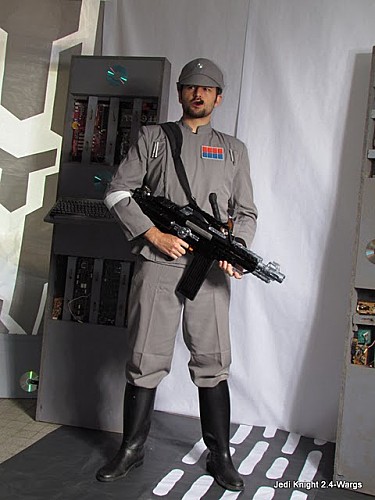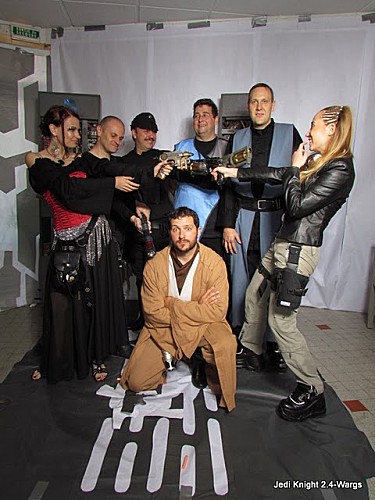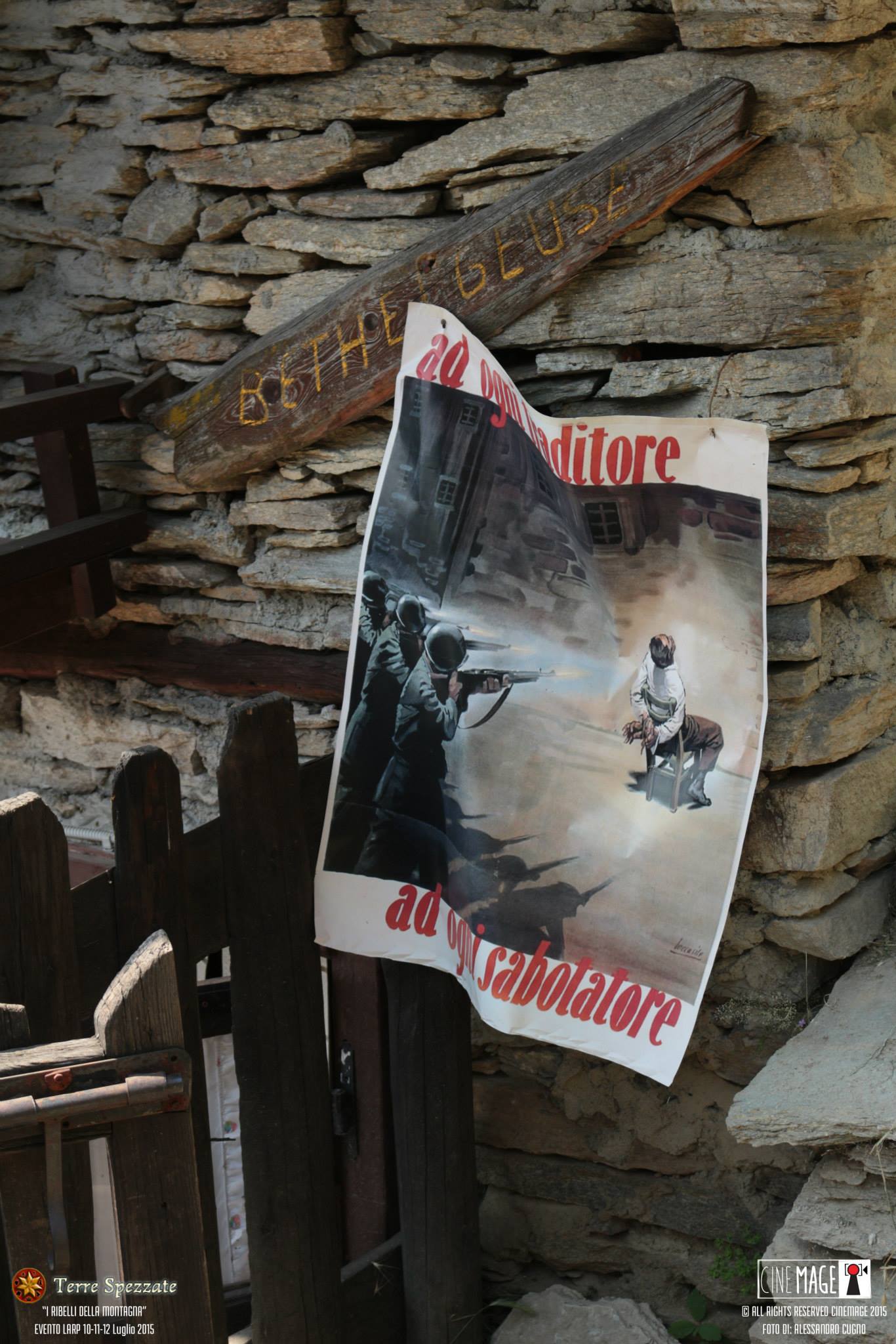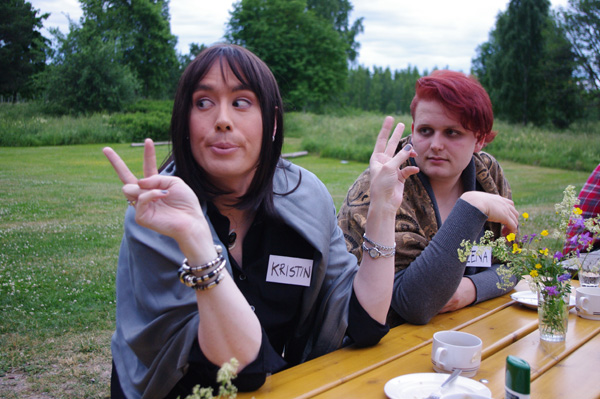Original post : http://www.electro-gn.com/474-critiquejediknight2-4
Translation : David Brosselin and Bruno Cailloux
The association Wargs wrote and organized three Larps in the Star Wars universe. The Jedi Knight series, 1, 2 and 3, who will soon have a younger sibling since episode 4 is in preparation.
Before you sink into confusion, please note that these Larps are not consecutive. As a matter of fact, they have no common characters, the position in the Star Wars timeline is different each time and more, you do not always play Jedis, despite the title. From the 1st to the 3rd of July 2011, near Chambery, the Rhône-Alpes association offered the 4th edition of the second opus in the series: Jedi Knight 2.4. aka JK2.4.
Still with me? Four editions for the same game, it deserves to be highlighted. Especially since the third session was organized in partnership with Rôle and Rêves de Licorne, which means this Larp, designed for about forty characters, was transmitted to different teams and conducted by people who had not created it. This is very rare. You may find “ready to play” scenarios for murder-parties (like on the excellent website www.murder-party.org), but reorganized scenarios for full-fledged Larps are not common, and those who are sufficiently well written down to be transmitted can be counted on the fingers of one hand. The game should be proposed again and if you regularly monitor their website you may get a ticket in a not so distant future : www.wargs.org
Why do I insist on the fact that the game has been reorganized? Because I was lucky enough to attend both the third and the fourth sessions. That is rare too. The explanation is quite simple. During the third edition, a handful of roles were added. They were characters on the fringe of the original script. So I could play again with little risk of already knowing the plots involving my new character. (And also, it helped that I’m a friend of the organizers because I’m such a nice guy)

First point of this review. I state that playing the same Larp twice, organized by two different teams, in two different places, with different players and with a different role, that makes for two very different experiences. Now I feel you do not regret picking up this article.
More seriously, characters of JK Larps (JK for Jedi Knight series) are designed through clusters. A cluster is a group of characters belonging to the same family of plots, and generally monitored by one author. That does not mean that players from the same cluster play partners and friends, far from it. They are even likely to have things to hide from one another. As the game goes without an unique overall plot, you may ignore what takes place outside of your cluster. So to replay in a group you had little or no interaction with in the first run is sometimes possible, and you truly won’t experience the same game.
Momentarily, I leave aside the technical and logistical issues because these are important points of this review that I will come to later. For now, I want to talk about writing. This Larp has existed on paper for 4 sessions. Obviously, it has undergone changes and adjustments. Backgrounds are long (about twenty pages) and they are highly novelized. And it’s well done!
Reading is very enjoyable, relevant information is readily available. The game is written well. This is even rarer than everything else so well worth reporting.
Beyond the character backgrounds, a series of events are provided to move your character’s story forward. Again, the ideas implemented were not the first that came to the organizers. The game is valuable for its intrigues with great dramatic potential, while remaining balanced with one another. However we regret that after so many readings and reorganizations, there are still bugs. Haaa, bugs! As a player, please always report them. As an organizer, remember to fix them for the next time around.
That’s all for the writing but take heed, reading one of the character sheets already justifies your participation in this Larp. On paper, JK2 is an outstanding product. I want to emphasize still a bit because afterwards we will talk about the practice and I will be less ecstatic.
This Larp takes place aboard a cruise spaceship. On this ship, there are more passengers than there are players. NPCs regularly come and go, frequently changing costumes, to simulate life on board and show we are far more than 40. Theoretically, this abundance of characters and the cluster division allows players to avoid crowding or interact at the wrong time with other players experiencing a major dramatic moment.
There is no risk of overcrowding in a LARP of this type because the place is also highly segmented. The ship is divided into several rooms and you can move from the dining hall to your private apartment, through the casino or the cantina. Even without the other areas, you have plenty of room for everyone. Despite the small number of players, you never feel like you’re playing in a small game.
Players have opportunities to explore many areas of the ship. They can even board a shuttle to go out and explore the surroundings. We shall return later to the management of all these events. However it is important to note that the JK games were not written by lazy people. Personally, when I am writing a scenario, if I can work around manufacturing props, I do not hesitate even for a moment. Wargs are experienced organizers. The idea of building a 25 meters long drill will no longer scare them. (true story)
Therefore, JK2 is expensive, but it was worth the money. The location is entirely decorated, from “good” to “very impressive!”. Just picture yourself wearing a space suit (including a helmet), crawling in corridors, your laser gun lighting devastated rooms filled with smoke. At the end of your progress, you find a nest of aliens haloed in green light. Don’t worry, no spoiler here, just an sample of what you might find on a JK.
Finally, costumes and makeup, on both the organizers and players side, are truly very cool. This is to be expected since the association is experienced. As players may manufacture an outfit with odds and ends, they can spend some money for great accessories and a little makeup.
Now you have a pretty good idea of what a JK Larp truly is. And I can deal with the main focus of this review: the system of sequential play. In theory, it is rather simple. Probably have you already experienced that one time or another during a game. Your character decides to go down in the cargo bay No. 54, although it is depressurized and invaded by aliens. Then you have to report it to the organizer in charge so he mobilizes the NPCs and scenery he needs. He sets up everything. Then tells you to move to the right spot.
During this time, you can put on your space suit, reload your gun, bid farewell to your wife and smoke a last cigar. Next you find out the cargo bay No. 54. At the risk of repeating myself, the place is so beautiful, a NPC on site embodies your father you thought forever lost, then there is a memorable action sequence and you leave the place in the last seconds before the bomb explodes. Take my word, it’s fabulous.
That is ideal sequential gaming. It’s really awesome because it stages many impressive settings, custom and varied scenes, all this in a small space because the same spot can serve for several different events.
Let’s be brutally honest. In practice, it worked less well. The location was 6 floors high and the (only) elevator broke down on Friday night. You can imagine the delays that may result to the NPCs and the organizers. NPCs were fewer than planned due to last-minute cancellations. The organizers were running around. (Yes, it’s a Larp. On 6 floors. Stairs, again and again. Ouch) The sequential gaming became very difficult to set up.
Despite the ambient mess, each organizer demonstrated a boundless ingenuity to properly manage the game. One reused an existing but defected scenery for staging an event all by himself, embodying the role of the main NPC. Another improvised a scene at 6 am when he finally found some free time.
But this is only possible for organizers who are familiar with the scenario. People who have become experts concerning the management of their cluster, throughout the four sessions.
After the game, I exchanged emails with the organizers. They agree that such a system needs improvement. However, Wargs is an organization able to reassess itself. This is evidenced by the fact that they completely rewrote the rule system for that session. Wargs had an “old-school” rule system of about forty pages, that for instance detailed all the Jedi powers. The game rules had been reduced to 4 pages for that session, to cleverly adapt to a new audience more concerned with storytelling than simulation.
How can we improve the system of sequential game ? The question remains open but it would not be surprising that an upcoming set of articles will attempt to answer it, but let’s explore some ideas. To organize an event, you need informed NPCs, properly installed scenery, and someone who knows the scenario to tie it all.
Maybe the solution lies in reusing the same elements ? Same settings, same costumes for NPCs, depending on the players involved in the sequential, only a different briefing for each bunch. I suppose there are many ways to grease the wheels. Increasing the number of NPCs and organizers should work too.
Anyway, we wish them good luck for the forthcoming session. Maybe I will be there as a NPC to see how it works on the other side of the mirror.
Jedi Knight 2 a game by Pascal Meunier, Xavier Gavioli, Christophe Trahand, Elizabeth Bates, and Vincent Marty




